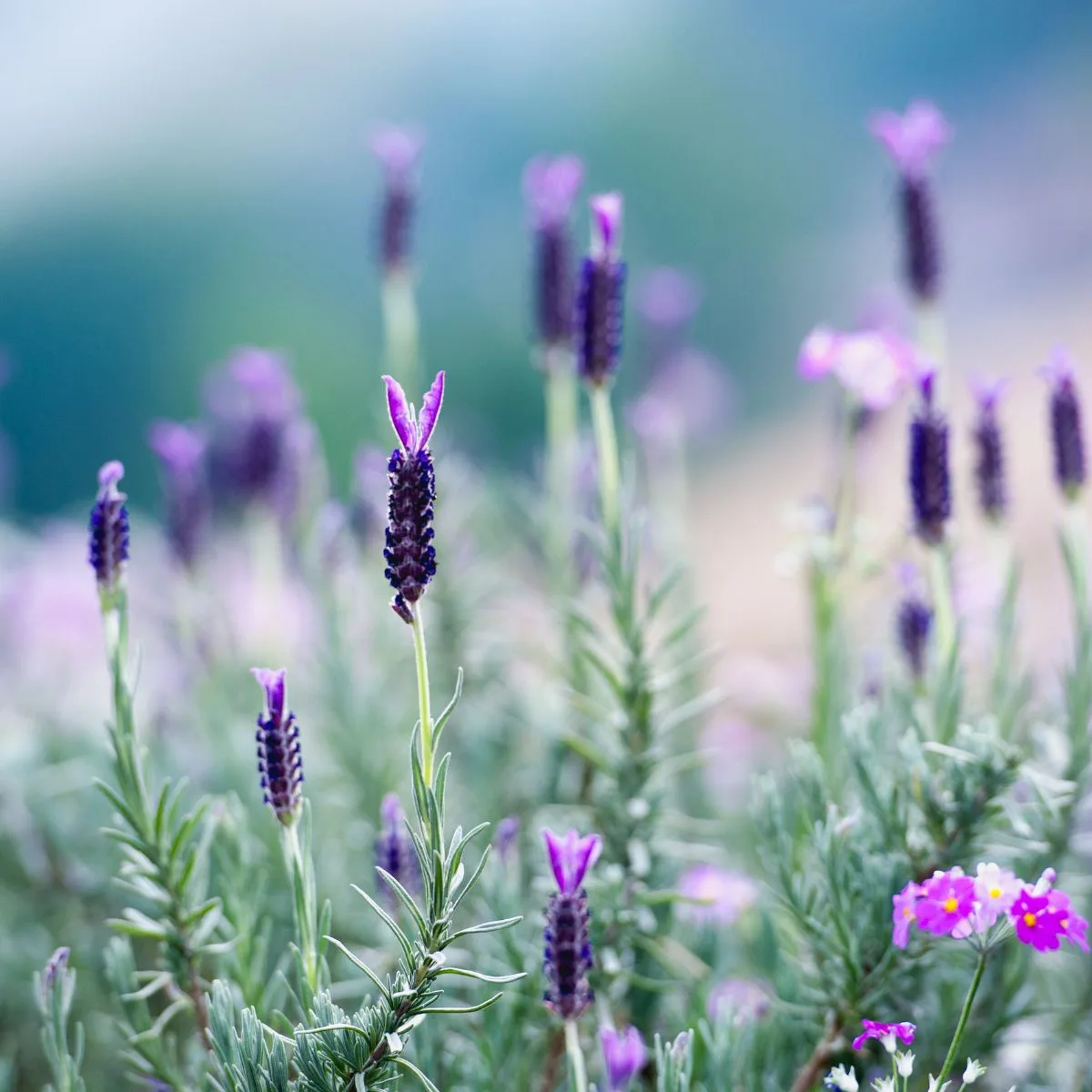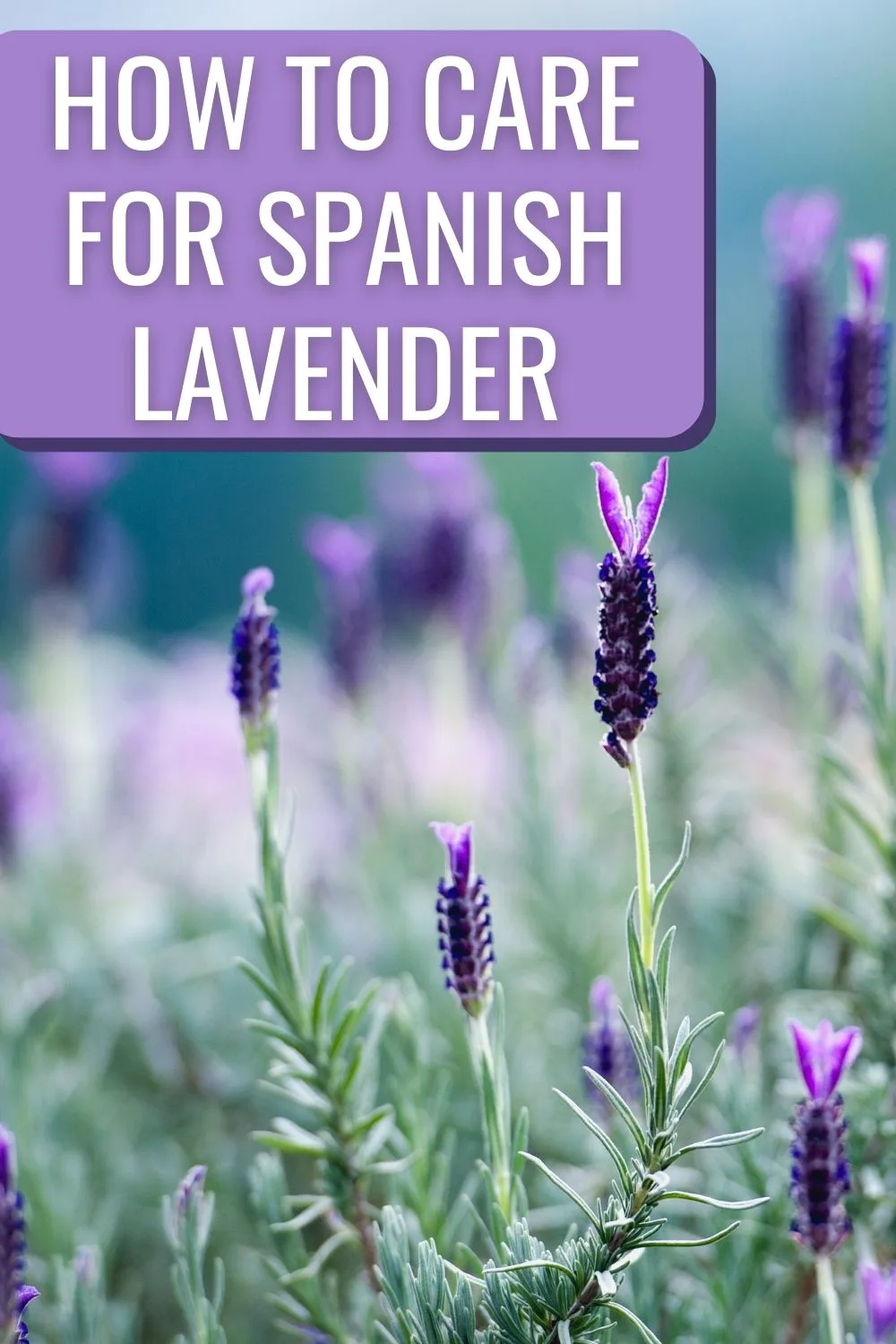Spanish lavender is a beautiful, bright flower known for its purple hues and intense fresh smell. It blooms in the late spring to summer and has become well-known in Spain, France, and other warm European climates. It’s a must-have for sun-filled flower gardens. So, if you wonder how to care for Spanish lavender, this guide will give you all the details.

Due to its beauty and fresh scent, many people want to grow their own Spanish lavender! For those just starting, this guide will give you the green thumb in no time. We’ll cover:
- Basic facts about the Spanish lavender
- How to care for the Spanish lavender variety, including optimal growing conditions and best watering, pruning, and fertilization practices
- Top tips for pruning and upkeep of your Spanish Lavender, as well as how to manage pests and disease
- Winter care requirements of Spanish Lavender
Let’s get started!
How to Care for Spanish Lavender
Basic facts about Spanish lavender
Spanish Lavender, as it is commonly known, also goes by the Butterfly Lavender or Bract Lavender. Its scientific name is Lavendula stoechas, and it comes from the Lamiaceae or mint family.
The Spanish Lavender prefers full sun exposure and moist, well-draining soil that is somewhat sandy and has neutral acidity.
Its flowers have a sweet, strong scent and come in a few beautiful colors: pink, purple, and white.

This book is an excellent guide for growing lavender
Ideal Growing Conditions

The growing conditions of Spanish lavender (and any other plant) are crucial to the success of your garden. Understanding hardiness zones, sunlight, soil, and temperature ranges will make you more likely to achieve better results with your lavender plants.
Hardiness zones best suited for Spanish Lavender
A hardiness zone is a numerical value assigned to specific regions based on their average temperature in winter.
This determines how cold it gets and helps growers determine which plants will survive best in their climate. The lower the number, the colder the winter will be on average.
Spanish lavender needs plenty of sunlight to grow, but it doesn’t need to be hot! Its zone is between 7-10 and optimal at zone 8, where the minimum winter temperature is around 10-20 ℉.
You can find your hardiness zone using this USDA website map.
Sunlight requirements
Full sunlight enhances the plant’s flowering and helps enhance its aromas and scents. So, make sure to plant this lavender type in full sun.
Perfect soil type and pH levels
Spanish Lavender needs soil that is well-draining. Like many plants, an environment with too much water that doesn’t drain can clog the roots and cause them to rot!
To counteract this, it’s vital to use sandy soil for optimal drainage. The acidity should be neutral to alkaline.
Optimal temperature range
The Spanish lavender is more sensitive to cold than other types of lavender and will not survive temperatures lower than 10 ℉. It thrives in warmer climates of 70-90℉.
Planting Spanish Lavender
When to plant
The best time to plant lavender is in the spring, once the soil has a chance to warm up (depending on your USDA zone, it could be as early as the end of April or as late as June). You can also plant in the fall, as long as you give the plant enough time to get established before winter.
Choosing a location
A location that has good, consistent sunlight is crucial for your lavender. Plant in a space with at least 6-8 hours of sunlight daily. A sunny location is necessary for proper growth and flowering.
Prepare the soil
Preparing your soil is an easy yet essential step to conserve moisture and temperature in the roots of your plants.
For Spanish lavender, the two most important factors are drainage and pH.
- The pH should sit between 7.0 and 8.0; you can conveniently use a kit to test it.
- It’s also vital to check the drainage. Dig a small hole in your soil and fill it with water. You’re good to go if the water is completely drained in a few hours!
Plant spacing
Spacing is something that is often forgotten when it comes to planting. However, air circulation between plants is crucial.
The bract lavender grows between 2 and 3 feet tall and wide, so keep that in mind when planting. If you’re planting your lavender in rows, leave extra space between plants for a walking path.
If you’re using pots, use one plant per pot (unless you’re using huge planters).
Ideal planting depth and initial post-planting care
Dig a hole about 1 inch bigger than your root ball on all sides. This will allow your plant to sit snugly but still have enough soil on and around it to ensure its protection.
If you’re planting from seed, plant them half an inch or an inch deep and cover them lightly with soil.
Initial post-planting care includes placing a layer of mulch on top to preserve moisture and temperature and ensuring the plants have water but are not drowning.
Water
All plants need water, and Spanish Lavender is no different!
Recommended watering frequency
Lavender can go a while without being watered, so if it rains frequently where you live, you may not have to water at all! If you need to water, avoid overhead watering.
However, let the top layers of soil become completely dry before watering your lavender.
The importance of drainage, and how to ensure it
Proper drainage is important for all lavender plants: it ensures that the soil and roots won’t become clogged and start to rot. To improve drainage, choose somewhat sandy and/or gravelly soil.
You could even mulch the lavender with gray rock, which makes it easy for the water to drain.
Indicators of both overwatering and underwatering
If you water your lavender plants too often, you’ll notice clogged-up soil and yellowing leaves. Water lavender sparely, and allow the first few layers to dry before you water again.
If your lavender lacks water, it will become dull and eventually dry.
Fertilization and Soil Maintenance
Spanish lavender doesn’t usually need fertilizer, as it is a neutral growing plant. However, fertilizer can be used on occasion to prompt and promote growth. Here are a few helpful pointers for fertilizing if you decide to do so:
- Only apply fertilizer in the early spring so that lavender has time to grow before it blooms in summer
- Only use low nitrogen and higher potassium fertilizers. Read about the scientific aspect of fertilizing lavender here: https://fertdirtsquirt.org/pdf/lavender.pdf
- Soil health is essential, so apply fertilizer sparingly and infrequently. Over-fertilizing can often cause too much growth, making the plant more susceptible to damage.
Learn more about fertilizing lavender.
Pruning
Pruning is crucial to the health of your plants!
- Pruning should be carried out in early summer. This way, the parts you cut off have time to grow again and produce more lavender in the coming year.
- Pruning can influence the shape of the plant, as well as overall flowering. By cutting off the dead heads, you can make room for healthier and newer lavender to grow.
- Don’t cut too deep into the plant.
Managing Pests and Diseases
Although lavender is quite adept at preventing pests and bugs, it can still be susceptible like all plants. Common pests for lavender can include:
- Spider mites
- Mealybugs
- Aphids
- Beetles
Use a strong water jet to get rid of these pests, and if necessary, you can also use a gentle insect soap that is safe for your lavender. This will help to discourage the habitation of bugs.
Potential diseases involve root rot, which we have already talked about as a possible side effect of overwatering.
If you notice the roots of your plant rotting, it may be beneficial to cut them out and avoid the further spread to other roots.
Here are the most common lavender problems.
Winter Care
After you finish harvesting for the season, lavender can use light pruning and shaping. Never cut the woody parts.
Also, increase the mulch level to insulate the roots in wintertime, and only water lavender if needed. The fall rainfall should be sufficient.
If you grow lavender in pots, move them to a greenhouse or garage for the winter.
Love Lavender? You May Like These Other Guides
- popular lavender varieties for culinary uses
- how to care for French lavender
- how to care for lavender topiaries
- how to grow lavender from seeds
- how to care for potted lavender
- the best potting mix for lavender plants
- best mulch for lavender
- how to save a dying lavender plant
- 8 ways to preserve lavender harvest
FAQs
Is Spanish lavender an annual or perennial plant?
Spanish lavender is a perennial in zones 7 through 10 but can be grown as an annual in zones 4 through 6. It’s so pretty that it’s worth getting a few plants each year, especially if you have a cottage Mediterranean garden or a rock garden.
What can you do with Spanish lavender?
Since this type of lavender is high in camphor and other fragrant compounds, it’s great for adding to aromatherapy products, makes great-smelling lavender oil, and is perfect for making lavender sachets.
Does Spanish lavender like sun or shade?
The stoechas need 6 to 8 hours of full sun to thrive. Lack of sunshine will keep them from flourishing, and you’ll get a much smaller flush of flowers or none at all.
Lavender is a relatively independent and hardy plant; gentle love and care are all it needs to thrive and add beautiful purple flowers to your garden. Happy planting!

Adriana Copaceanu is a passionate nature lover living in the country on her dream property where she grows vegetables, lavender, and wildflowers that she shares with the wildlife they attract. When she's not in the garden, she loves spending time with her chickens and planning her next nature project. Check out her books below:
How to Grow Lavender for Fun and Profit: Lessons Learned from Planting Three Hundred Lavender Plants


Kristin
Wednesday 27th of September 2023
Where can one purchase seeds for this variety?
Adriana
Thursday 28th of September 2023
Amazon has them here: https://amzn.to/46sFGwL, but seeds don't always grow true to the mother plant. Your best bet would be to but a plant form your local nursery in the spring.